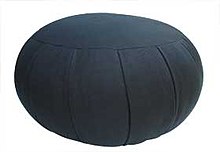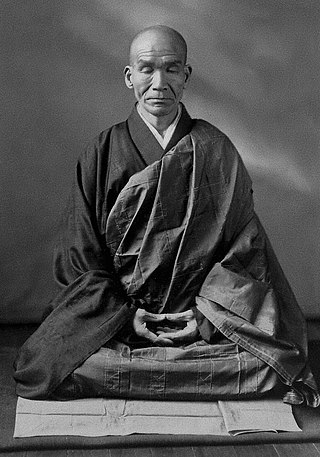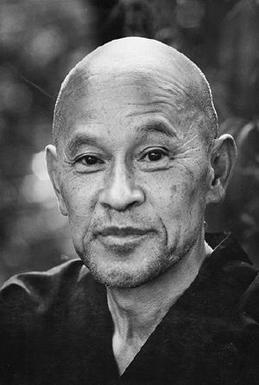
A zafu (Japanese : 座蒲, pronounced [d͡zaɸɯ] ) or putuan (Chinese :蒲团, pronounced [pʰǔ.tʰwǎn] ) is a round cushion. Although also a utilitarian accessory, it is best known for its use in zazen Zen meditation.

A zafu (Japanese : 座蒲, pronounced [d͡zaɸɯ] ) or putuan (Chinese :蒲团, pronounced [pʰǔ.tʰwǎn] ) is a round cushion. Although also a utilitarian accessory, it is best known for its use in zazen Zen meditation.
Although zafu is often translated as "sewn seat" in American English, the meaning of the Japanese kanji, 座蒲, is different. Za (座) means "seat", and fu (蒲) means reedmace (cattail, Typha spp.). A zafu is a seat stuffed with the fluffy, soft, downy fibres of the disintegrating reedmace seed heads. The Japanese zafu originates in China, where these meditation seats were originally filled with reedmace down.
The words zabuton , zafuton and futon are closely linked. The word zazen meaning "seated meditation" or "sitting meditation" is also closely linked. In western usage, zafu refers to a meditation cushion, and zabuton refers to the cushioned mat upon which a zafu is placed.
Typical zafus are about 35 centimetres (14 in) in diameter, [1] and often about 20 centimetres (8 in) high when fluffed. Contemporary zafus are sewn from three pieces of heavy cloth, usually colored black: two round swatches of equal size for the top and the bottom of the cushion, and a long rectangle that is sewn into gathers in between. They are typically filled with either kapok (a fluffy plant fibre, similar to Typha) or buckwheat hulls. Zen Buddhist practitioners traditionally sit on a zafu when engaged in sitting meditation. The cushion raises the hips, making the entire range of cross-legged sitting positions more stable for the meditator.

Before and after practicing zazen, Zen practitioners perform a gassho bow to the zafu, to fellow practitioners, and to the teacher. In many practice places, there is a prescribed form for respectfully handling zafu while walking in the meditation hall, or zendo.
A zabuton (Japanese : 座布団, [d͡zabɯtoɴ] ) is a rectangular cushion, about 76 centimetres (30 in) by 71 centimetres (28 in), that is often used under a zafu cushion to provide comfort and support when engaged in zazen. The outer cover is typically made of a heavy duty fabric and has a zipper along one side so that it can be easily removed and washed. Inside the cover, the batting is enclosed in a natural cotton casing.

Dōgen Zenji, was a Japanese Zen Buddhist monk, writer, poet, philosopher, and founder of the Sōtō school of Zen in Japan. He is also known as Dōgen Kigen (道元希玄), Eihei Dōgen (永平道元), Kōso Jōyō Daishi (高祖承陽大師), and Busshō Dentō Kokushi (仏性伝東国師).

A dōjō is a hall or place for immersive learning, experiential learning, or meditation. This is traditionally in the field of martial arts. The term literally means "place of the Way" in Japanese.

Zazen is a meditative discipline that is typically the primary practice of the Zen Buddhist tradition.

Shunryu Suzuki was a Sōtō Zen monk and teacher who helped popularize Zen Buddhism in the United States, and is renowned for founding the first Zen Buddhist monastery outside Asia. Suzuki founded San Francisco Zen Center which, along with its affiliate temples, comprises one of the most influential Zen organizations in the United States. A book of his teachings, Zen Mind, Beginner's Mind, is one of the most popular books on Zen and Buddhism in the West.
Satori is a Japanese Buddhist term for awakening, "comprehension; understanding". It is derived from the Japanese verb satoru.
Shikantaza (只管打坐) is Dogen's Japanese translation of the Chinese phrase zhǐguǎn dǎzuò, "focus on meditative practice alone," although many modern Western practitioners have interpreted this very differently. The phrase was used by Dogen's teacher Rujing, a monk of the Caodong school of Chan Buddhism, to refer to the meditation-practice called "Silent Illumination", or "Serene Reflection," taught by the Caodong master Hongzhi Zhengjue (1091–1157). In Japan, it is associated with the Zen Soto school, Dogen's offshoot of Caodong. Some practitioners teach that shikantaza means that one should not focus attention on a specific object, instead "just sitting" in a state of conscious awareness; however, the 13th-century origin of the expression indicates a general emphasis on meditation in any form as sufficient for spiritual enlightenment. The original teaching was meant to criticize the complicated ceremony, abstruse study, endless tracing of spiritual lineage, and other aspects of Buddhism that even by the 12th century had been identified as excessive.

A sesshin is a period of intensive meditation (zazen) retreat in a Japanese Zen monastery, or in a Zen monastery or Zen center that belongs to one of the Japanese Zen traditions outside of Japan.

Zendō (禅堂) or senbutsu-jō (選仏場) is a Japanese meditation hall. In Zen Buddhism, the zen-dō is a spiritual dōjō where zazen is practiced. A full-sized Zen Buddhist temple will typically have at least one zen-dō as well as a hon-dō, which is used for ceremonial purposes, plus a variety of other buildings with different functions. However, any place where people go to practice Zen can be referred to as a zen-dō.

Seiza is the formal, traditional way of sitting in Japan. It involves a specific positioning and posture in a kneeled position so as to convey respect, particularly toward elders. It developed among samurai during the Edo period and was later widely adopted by the public.

The Rinzai school, named after Linji Yixuan is one of three sects of Zen in Japanese Buddhism, along with Sōtō and Ōbaku. The Chinese Linji school of Chan Buddhism was first transmitted to Japan by Myōan Eisai. Contemporary Japanese Rinzai is derived entirely from the Ōtōkan lineage transmitted through Hakuin Ekaku (1686–1769), who is a major figure in the revival of the Rinzai tradition.
The term makyō is a Japanese word that literally means "realm of demons/monsters" or "uncanny realm" or forsaken place, and hellhole.
A zazenkai (座禅会), literally meaning "to come together for meditation" is a Zen Buddhist retreat that is usually less intensive and of shorter duration than sesshin. It may comprise a short meeting, without liturgical service, headed by a monastic, or by a group of practitioners without the presence of a teacher. It is also sometimes used to refer to a meeting of lay practitioners who practice together regularly without a resident teacher. It can also denote a period of zazen in a temple schedule.

A zabuton is a cushion for sitting that is commonly used in traditional Japanese settings. Zabuton is a Japanese loanword that is also sometimes used in Western culture to describe the zaniku, a flat mat that a zafu is placed on.

Sōji-ji (總持寺) is one of two daihonzan of the Sōtō school of Zen Buddhism. The other is Eihei-ji temple in Fukui Prefecture. Fodor's calls it "one of the largest and busiest Buddhist institutions in Japan". The temple was founded in 740 as a Shingon Buddhist temple. Keizan, later known as Sōtō's great patriarch Taiso Jōsai Daishi, founded the present temple in 1321, when he renamed it Sōji-ji with the help and patronage of Emperor Go-Daigo. The temple has about twelve buildings in Tsurumi, part of the port city of Yokohama, one designed by the architect Itō Chūta.

Myōe (明恵) was a Japanese Buddhist monk active during the Kamakura period who also went by the name Kōben. He was a contemporary of Jōkei and Hōnen.

The kamiza is the "top seat" within a room, meaning the seat of honor; the term also applies to the best seats in air-planes, trains, and cars. The antonym, meaning "bottom seat," is shimoza (下座). In a room, the kamiza is the seat or position that is most comfortable, usually furthest from the door – because this is warmest, and was safest from attack back in the feudal period. In a traditional washitsu room, it would often be a zabuton placed so the person sitting there has his back to the tokonoma; the kamiza is the spot closest to the tokonoma or simply farthest from the door in a room lacking a tokonoma. In a Western-style room, it would be a comfortable armchair or sofa, or the head of a table. The term is general, and does not only apply to Japanese culture.
Bendōwa (辨道話), meaning Discourse on the Practice of the Way or Dialogue on the Way of Commitment, sometimes also translated as Negotiating the Way, On the Endeavor of the Way, or A Talk about Pursuing the Truth, is an influential essay written by Dōgen, the founder of Zen Buddhism's Sōtō school in Japan.

In the oldest texts of Buddhism, dhyāna or jhāna is a component of the training of the mind (bhavana), commonly translated as meditation, to withdraw the mind from the automatic responses to sense-impressions, "burn up" the defilements, and leading to a "state of perfect equanimity and awareness (upekkhā-sati-parisuddhi)." Dhyāna may have been the core practice of pre-sectarian Buddhism, in combination with several related practices which together lead to perfected mindfulness and detachment.

Meditative postures or meditation seats are the body positions or asanas, usually sitting but also sometimes standing or reclining, used to facilitate meditation. Best known in the Buddhist and Hindu traditions are the lotus and kneeling positions; other options include sitting on a chair, with the spine upright.

Zen is a school of Mahayana Buddhism that originated in China during the Tang dynasty as the Chan School or the Buddha-mind school, and later developed into various sub-schools and branches. From China, Chán spread south to Vietnam and became Vietnamese Thiền, northeast to Korea to become Seon Buddhism, and east to Japan, becoming Japanese Zen.